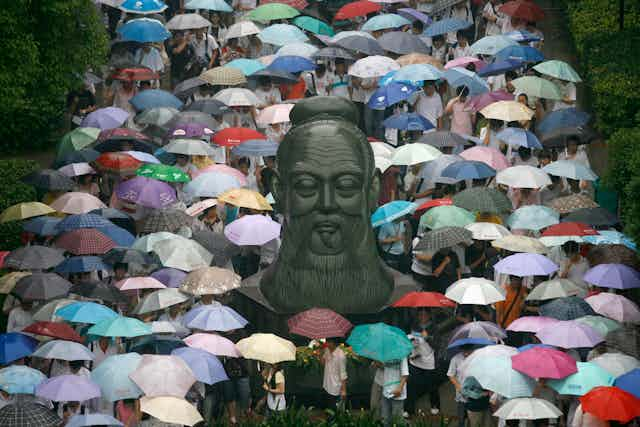Reports that a beauty salon in the Chinese city of Guangzhou deducts 5% to 10% of employees’ wages and deposits the money into their parents’ bank accounts sparked much debate recently in China. The company also actively promotes the Confucian virtue of “filial piety”, or respect for one’s parents, among its employees.
The company’s policy exemplifies the coming together of two current phenomena in China: the pressures brought on by an ageing population, and the renewed interest in Confucianism. After being denounced during Mao’s rule, the ideas of the ancient Chinese sage Confucius, who was born around 551BCE, are now gaining currency at both a social and political level.
China’s youth today face the pressure of not only finding a job, but also a home and raising a family. When young Chinese grow up, the importance of supporting their parents in their old age is firmly instilled in them, too.
This was illustrated by an online discussion about the beauty salon’s “tax”: many commentators clearly believed that it was the moral responsibility of children to be filial towards their parents. While many supported the company’s motivations, there was some disagreement about the extent to which a private company should be involved. Others argued that true filiality requires sincerity and goes beyond money.
This concept of filiality is an example of a bottom-up, popular interpretation of Confucian virtues by citizens in contemporary China. But just as there was disagreement about the company’s tax online, Confucius’s journey back to political acceptability has not been without setbacks.
A long road back

When a statue of Confucius appeared outside the National Museum, and next to Tiananmen Square in 2011 – before Xi Jinping took over as president – China-watchers wondered if something revolutionary had happened. After all, the square is one of modern China’s most symbolic spaces. It was where Mao proclaimed the establishment of the People’s Republic in 1949, where demonstrations took place in 1976, and where the pro-democracy protests of 1989 began. Soon afterwards, though, the statue had been removed – possibly the authorities had had a change of heart.
Similarly, when the film Avatar started generating massive box office returns in 2010, seemingly at the cost of the state-backed biopic Confucius, James Cameron’s picture was temporarily removed from 2D screens. At the time, reports suggested this was a deliberate measure to increase the revenue of Confucius. Despite this, Avatar still broke box-office records in China, while Confucius, starring Chow Yun Fat in the title role, made less impressive gains.
The recent reemergence of Confucius and his thinking, however, is a big step forward for the sage. It’s a far cry from the days of the Cultural Revolution between 1966 and 1976 when he was denounced as a representative of the “Four Olds” (old ideas, old culture, old customs, and old habits) – and the “Criticise Lin, Criticise Confucius Campaign” of 1974 to 1976. During that, he was critiqued alongside defence minister Lin Biao, who was derided as a reactionary.
But those days are gone. While the statue of Confucius near Tiananmen was moved from its original prominent position, it did later reappear in the museum’s courtyard. That same year, a giant silicon bust of Confucius was put on display in the Rockbund Art Museum in Shanghai, too.
And the sage’s rise continues. The Ministry of Education is also examining the role of “traditional” values in textbooks. In 2013, a law decreed that children must visit their elderly parents.
The Hanban, “a public institution affiliated with the Chinese Ministry of Education”, has opened 480 Confucius Institutes around the world. And in Guiyang, the Confucian scholar Jiang Qing has opened a “Confucius Academy”, which aims to spread the philosophy.
Even China’s president, Xi Jinping, has been positive about Confucianism. On the 2,565th anniversary of the sage’s birth in 2014, he remarked that: “Confucianism and other schools of thought in Chinese history all adhered to the principle that theories must serve the management of state affairs and benefit real life.” He went on: “Chinese Communists are neither historical nihilists, nor cultural nihilists.” This stance creates a space for traditional philosophers to be discussed in the political arena, especially in support of top-down governance such as China’s.
Keeping the social order
At its most basic level, Confucianism teaches that civic order comes from individuals fulfilling their specific, socially defined roles. This is most explicitly stated in the canonical text The Great Learning, which explains that political, social and familial order comes from regulation of the self.
In a political sense, Confucianism might have appeal as a philosophy that can promote stability at a time of change. This ideal of stability is reflected in former president Hu Jintao’s “Harmonious Society” concept, which complements the Confucian emphasis on harmony.

Meanwhile, China is also faced with an ageing population. By 2040, 28.1% of the Chinese population will be over 60, compared to 12.4% in 2010, according to the UN. So, in light of Xi’s call for Confucianism to benefit society in concrete ways, private initiatives to support ageing parents might be welcomed.
Confucius isn’t gate-crashing the Party: the hosts have invited him in. But as the beauty salon in Guangzhou shows us, Confucian values are back at the social level, too. Parents send their children to Confucian kindergartens, and Yu Dan’s Confucian self-help book was a bestseller.
Confucius himself said that: “at 60 my ear was obedient; at 70 I could follow my heart’s desire without transgressing the norm.” If the “filial piety tax” catches on, perhaps ageing parents, like the government, will take some heart from this.

